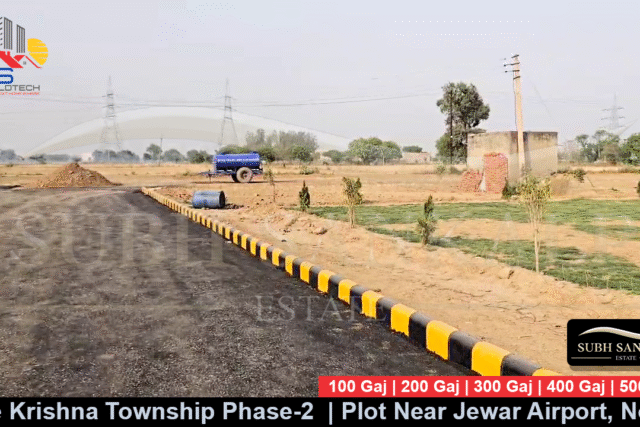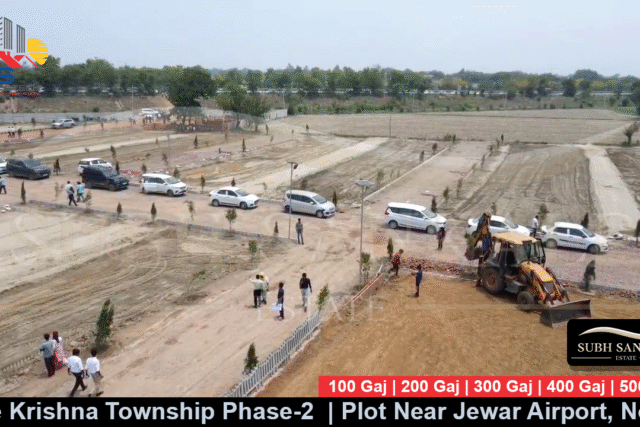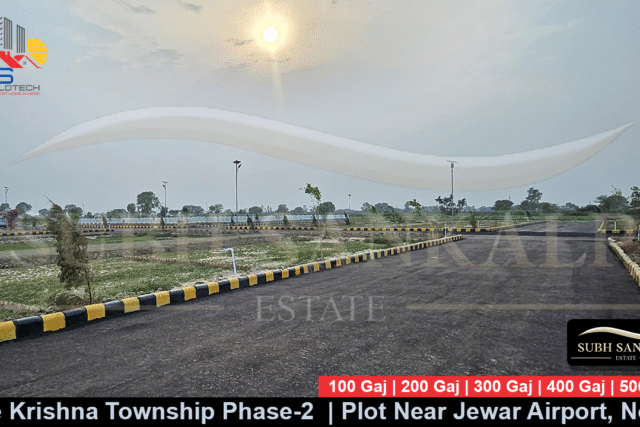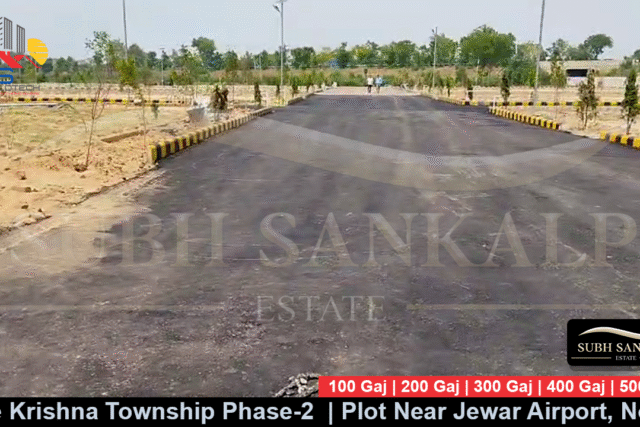The emergence of Noida International Airport at Jewar has created unprecedented opportunities for large-scale land development, and the 1500 Gaj Jewar Airport Ke Pass Plot – Hare Krishna Township Phase 2 represents the pinnacle of strategic land banking in this transformative corridor. This massive land parcel offers developers and institutional investors the unique opportunity to create self-sustained micro-markets and shape the future urban landscape of the Delhi-NCR region.
1. Unprecedented Scale and Development Potential
A 1500 Gaj plot represents a massive landholding of 1500 square yards or approximately 13,500 square feet (1,254 square meters). This extraordinary scale enables:
- Development of integrated townships with comprehensive amenities
- Creation of mixed-use developments spanning multiple sectors
- Phased development over several years maximizing returns
- Strategic land partitioning for different uses and market segments
- Development of institutional campuses or specialized economic zones
2. Strategic Positioning in the Growth Corridor
The location advantages of these mega-plots are unparalleled:
- Airport Proximity: Strategic positioning within 3-7 km of the airport boundary
- Infrastructure Access: Direct access to YEIDA’s developed sectors with complete infrastructure
- Multi-modal Connectivity: Enhanced by Yamuna Expressway, upcoming metro, and freight corridors
- Future-ready Location: Positioned at the epicenter of the aerotropolis development
- Premium Sector Advantage: Typically located in fully developed sectors with social infrastructure
3. Unmatched Investment Proposition
The investment potential of 1500 Gaj plots is extraordinary:
- Maximum Appreciation: Largest land parcels show highest percentage appreciation in developing corridors
- Development Leadership: Scale allows creation of market-defining projects
- Institutional Interest: Attracts REITs, private equity, and international developers
- Risk Mitigation: Size allows phased development reducing market cycle risks
- Value Creation: Opportunities for land value enhancement through strategic development
4. Comprehensive Development Possibilities
The scale enables revolutionary project concepts:
- Integrated Township: Self-contained community with residential, commercial, and social infrastructure
- Special Economic Zone: Sector-specific development for IT, healthcare, or logistics
- Educational Hub: University campus or multiple institutional setup
- Hospitality District: Combination of hotels, serviced apartments, and convention centers
- Planned Industrial Park: For airport-dependent industries and logistics
5. Market Dynamics and Investment Landscape
Current market analysis reveals:
- Premium Valuation: Prices range from ₹ 70,000 to ₹ 1,50,000+ per square yard based on location advantages
- Limited Availability: Extreme scarcity of contiguous land parcels of this scale
- Developer Competition: High interest from top-tier developers and institutional funds
- Price Leadership: These parcels often set benchmark prices for their sectors
- Future Growth: Projected 3-5x appreciation over the next 7-10 years
6. Legal Framework and Development Regulations
Key regulatory considerations include:
- YEIDA Master Plan: Compliance with sector development regulations and land use norms
- Environmental Clearances: Comprehensive assessments for large-scale development
- Project Approvals: Multi-layer sanction process for township projects
- Infrastructure obligations: Development of external infrastructure contributions
- Phased Development: Regulations governing multi-phase project execution
1. What specialized expertise is required for managing a 1500 Gaj plot investment?
Managing this scale requires:
- Township planning and architectural expertise
- Project management capabilities for large developments
- Legal expertise in multi-layer regulatory compliance
- Financial structuring knowledge for phased funding
- Market analysis skills for strategic development planning
Most investors partner with specialized development firms or hire expert consultants.
2. How does the funding structure work for such large land acquisitions and subsequent development?
Funding typically involves:
- Land acquisition through syndicated debt or investor consortium
- Construction funding through project financing
- Private equity participation for specific phases
- Joint development agreements with strategic partners
- Structured exit financing for completed phases
Most projects use a combination of debt and equity tailored to different development stages.
3. What are the key advantages of a 1500 Gaj plot over assembling multiple smaller parcels?
Significant advantages include:
- Unified planning and integrated development
- Better infrastructure planning and cost optimization
- Faster approval processes for single large parcels
- Higher valuation premiums for integrated projects
- Avoidance of title fragmentation issues
- Strategic positioning as a market leader in the sector
4. What are the typical development timelines and phasing strategies for such large parcels?
Standard approach includes:
- Phase 1 (Years 1-2): Land development and basic infrastructure
- Phase 2 (Years 2-4): Core project development and first occupancies
- Phase 3 (Years 4-6): Project completion and value-added development
- Phase 4 (Years 6-8): Strategic land banking and future development
Most developers adopt a 7-10 year horizon for complete value realization.
5. How does the exit strategy differ for 1500 Gaj plots compared to smaller land parcels?
Exit strategies are more sophisticated:
- Phased monetization through developed units
- Strategic stake sales to institutional partners
- REIT formation for income-generating assets
- Project-level private equity exits
- Long-term land leasing arrangements
- Development management contracts with guaranteed returns
















Leave a review for 1500 Gaj Jewar Airport Ke Pass Plot – Hare Krishna Township Phase 2